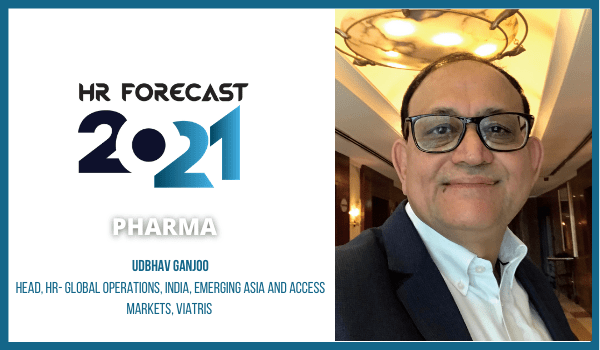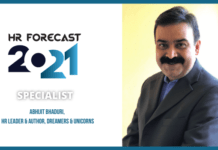2020: What to learn – what to erase
One blessing in disguise was the quick adoption and usage of technology that enabled large sections of our employee base to support operations remotely. Decisions were made faster and people came together to support each other and the organisation. Many out-of-the box ideas were born and implemented during this time. One thing I would want to erase is the overall suffering and pain that humanity has collectively undergone, and the losses people have endured. I am hopeful that the new year will be full of new beginnings, so that we are able to leave the past behind and move forward carrying only the positives of 2020 with us.
HR has shown great agility and business acumen
Employees from multiple teams and functions rolled up their sleeves and partnered to ensure business continuity and meet demand. Human resources played a crucial role to help business prioritise the health and safety of employees. It helped put in place supporting policies, processes and frameworks to enable additional health insurance coverages, special bonuses, employee wellbeing initiatives, employee engagement, business continuity plans, and so on. As long as HR continues to fulfill its roles of strategic partner, change agent, employee champion and administrative expert, it will continue to deliver business results, cultural resilience/ flexibility, engaged employees and efficient HR policies. It will continue to have a tangible business impact and consequently have a seat at the table.
HR also needs to be more resilient
Resilience is not a new business concept, but the pandemic has magnified its importance as an enterprise-wide capability. There are multiple dimensions to resilience — from individual level to leadership and cultural resilience across the organisation. At a functional or organisational level, resilience denotes the ability of the organisation to withstand a volatile or even hostile environment and successfully adapt, innovate and lead through the flux. This kind of institutional resilience is built through individual resilience in people, systemic resilience in processes and foundational resilience in IT, system and supply chain infrastructure. HR must play a critical role in embedding resilience within the organisation. First, the team must analyse risks to resilience across people, processes and infrastructure, focusing on key items such as succession planning, turnover, health and safety. Then HR must align stakeholders across functions, including legal, PR and finance, to ensure that the mitigants are put in place to manage these risks and build organisational resilience.
“Standardised HR processes will need to be rejigged, to meet the needs of a segmented workforce within an organisation”
Managing hybrid workforce is more challenging
There are several challenges with managing a hybrid workforce that organisations adopting this model will need to anticipate and mitigate. The first is determining the eligible population, objectively, to reduce employee perceptions of inequity. Human resource leaders will need to use a task-based lens to determine what work can be done remotely and how often, minimising subjectivity and maximising organisational efficiency and impact. Additionally, studies indicate that lack of social interaction during remote working can exacerbate feelings of loneliness and isolation, as well as erode the social capital and culture of the organisation. This, coupled with the blurring of personal and professional boundaries while working from home, can significantly augment stress. To combat this, employers will need to increase virtual interactions, build in-person touchpoints and foster intentional engagement strategies to preserve employee engagement, social capital and organisational culture. Standardised HR processes will need to be rejigged, to meet the needs of a segmented workforce within an organisation.
Efficiency or Flexibility – what will change the organizations design in 2021
In 2021, organisations will be much more focused on their mission and objectives, and on delivering value to all stakeholders. Organisations will be redesigned to ensure both efficiency and flexibility. The pace of change that 2020 brought about, made certain changes take place in an on-the spur, ad-hoc manner to meet the immediate business needs – whether it was flexible work options or usage of digital means for activities that were done face-to-face. These changes will become more structured in 2021. Can we do more with less? How do we empower our employees to make faster decisions? Are our employees skilled enough to meet the current and future organisation targets? Are we leveraging all our resources optimally to provide the best results? All these questions will be answered by framing new policies and work processes, and by aligning structures. This will ensure that the employees’ and organisation’s need for flexibility is matched with higher outputs.
“Resilience is not a new business concept, but the pandemic has magnified its importance as an enterprise-wide capability”
Shift of talent calculus to more buy-and-rent and less build
The talent calculus will be flexible to meet organisation needs. The talent strategy will be driven by the individual organisation’s long-term strategy and short-term objectives. Depending on the organisation and industry that one is in, there will be more openness in utilising resources as and when needed. However, the need to build existing talent to be more agile will be stronger than before. In research-driven industries dealing with proprietary information, the focus will be more on building internal talent to meet current and future business needs. For industries where certain tasks are either periodic, or repetitive and manual in nature, organisations may look at ways to outsource these. For strategic roles and functions, which will be growth drivers, organisations will continue to build internal talent pools. Overall, it will not be a simple buy, rent or build call. For different tasks and functions, organisations will employ all three models on a need basis.
Value our content... contribute towards our growth. Even a small contribution a month would be of great help for us.
Since eight years, we have been serving the industry through daily news and stories. Our content is free for all and we plan to keep it that way.
Support HRKatha. Pay Here (All it takes is a minute)




































